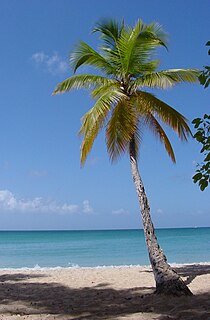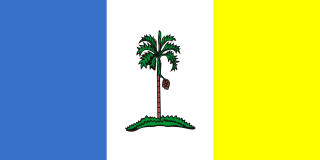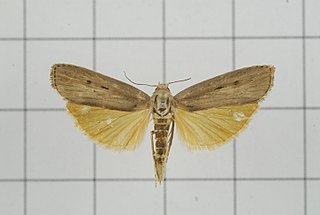
The Arecaceae are a botanical family of perennial plants. Their growth form can be climbers, shrubs, trees and stemless plants, all commonly known as palms. Those having a tree form are colloquially called palm trees. They are flowering plants, a family in the monocot order Arecales. Currently 181 genera with around 2600 species are known, most of them restricted to tropical and subtropical climates. Most palms are distinguished by their large, compound, evergreen leaves, known as fronds, arranged at the top of an unbranched stem. However, palms exhibit an enormous diversity in physical characteristics and inhabit nearly every type of habitat within their range, from rainforests to deserts.

The areca nut is the fruit of the areca palm, which grows in much of the tropical Pacific, Southeast and South Asia, and parts of east Africa. It is commonly referred to as betel nut so it is easily confused with betel leaves that are often used to wrap it (paan). The term areca originated from the Kannada word adike (ಅಡಿಕೆ) and dates from the 16th century, when Dutch and Portuguese sailors took the nut from Kerala to Europe. Consumption has many harmful effects on health and is carcinogenic to humans. Various compounds present in the nut, including arecoline, contribute to histologic changes in the oral mucosa. It is known to be a major risk factor for cancers of the mouth and esophagus. As with chewing tobacco, its use is discouraged by preventive efforts. Consumption by hundreds of millions of people worldwide – mainly with southern and eastern Asian origins – has been described as a "neglected global public health emergency".

Kamphaeng Phet is a province (changwat) of Thailand in the upper center of the country. Neighbouring provinces are Sukhothai, Phitsanulok, Phichit, Nakhon Sawan, and Tak.

Paan is a preparation combining betel leaf with areca nut widely consumed throughout Southeast Asia, Taiwan, and South Asia. It is chewed for its stimulant and psychoactive effects. After chewing it is either spat out or swallowed. Paan has many variations. Slaked lime (chunnam) paste is commonly added to bind the leaves. Some South Asian preparations include katha paste or mukhwas to freshen the breath.

Areca catechu is a species of palm which grows in much of the tropical Pacific, Asia, and parts of east Africa. The palm is believed to have originated in the Philippines, but is widespread in cultivation and is considered naturalized in southern China, Taiwan, India, Bangladesh, the Maldives, Ceylon, Cambodia, Laos, Thailand, Vietnam, Malaysia, Indonesia, New Guinea, many of the islands in the Pacific Ocean, and also in the West Indies.

Penang Island, is the main constituent island of the Malaysian state of Penang. Located at the Malacca Strait, off the northwestern coast of Peninsular Malaysia, it is separated from the mainland by the Penang Strait. The island is home to nearly half of Penang's population; the city of George Town, which covers the island and the five outlying islets, is Malaysia's second largest city by population.

Arecoline is a nicotinic acid-based alkaloid found in the areca nut, the fruit of the areca palm. It is an odourless oily liquid.

The Barbel palm is a critically endangered palm endemic to Mauritius, Rodrigues, and La Reunion that is prized for its edible palm hearts.

Areca triandra is a palm which is often used as ornamental plant. It is native to India, Bangladesh, Cambodia, Laos, Burma, Thailand, Vietnam, Malaysia, Indonesia, and the Philippines. It is also reportedly naturalized in Panama and in southern China.
Areca ipot, the Ipot palm, is a species of flowering plant in the Arecaceae family. It is endemic to the Philippines. It is threatened by habitat loss.

The civic coat of arms of Penang is largely based on the coat of arms of Penang first granted to the Settlement of Penang, then in the Federation of Malaya, by a Royal Warrant of King George VI dated 11 September 1949.

The state flag of Penang, a Malaysian state, consists of three vertical bands and an areca-nut palm on a grassy mount in the centre. All three bands are of equal width. From left to right, the colour of each band is light blue, white and yellow.
Areca is a genus of single-stemmed palms.
Areca gurita is an extant species of single-stemmed palm tree indigenous to the Malaysian state of Sarawak on Borneo. Following Heatubun's identification of A. gurita in 2011, he recorded specimens in the vicinity of Kota Padawan, Kampong Patak, and Kampung Siburan, south of Kuching.

Tirathaba mundella, the oil palm bunch moth, is a species of snout moth. It is found in Malaysia.

Areca nut production in India is dominant in the coastal region within 400 kilometres (250 mi) from the coast line, and also in some other non-coastal states of India. Areca nut, a tropical crop, is popularly known as betel nut, as its common usage in the country is for mastication with betel leaves. It is a palm tree species under the family of Arecaceae. It has commercial and economic importance not only in India but also in China and Southeast Asia.

Areca vestiaria is a species of palm native to the rainforests of eastern Indonesia especially North Sulawesi. Its morphology is more diverse than other species of palms, and in particular the color of its upper trunk / crownshaft changes depending on altitude.
















